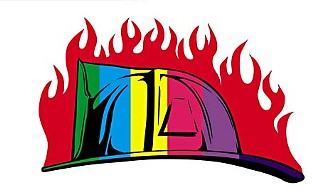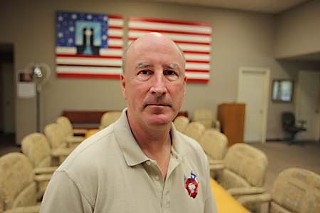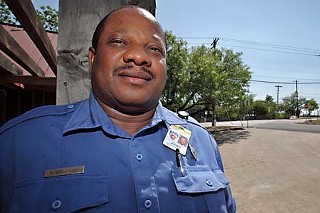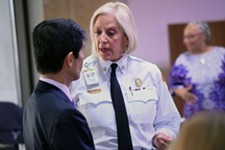The Color of Fire
The Austin Fire Department is making yet another attempt at staff diversity – will it do any better this time?
By Josh Rosenblatt, Fri., May 13, 2011
There was a time not so long ago when Austin's public officials concerned themselves with the business of running the city, and reporters wrote about how well or badly those officials were doing what they said they would do. Those were the good old days, when council members would engage in lengthy public debates about water treatment plants and historic districts and incentive packages instead of listening to endless lectures about how many council members are legally allowed to screw in a light bulb – or send an email about it – at the same time.
Recalling those halcyon days, you might have forgotten that City Hall's current "open-government" fiasco actually started somewhere real, that those emails Mayor Lee Leffingwell and Mayor Pro Tem Mike Martinez exchanged with each other during a particularly heated council meeting back in April 2010 – the ones pointed to as proof of rudeness at best and conspiracy at worst – were actually related to legitimate matters in the Austin Fire Department. Over the testy objections (public and private) of Leffingwell and Martinez (joined in their "no" votes by Council Member Laura Morrison), council voted to spend hundreds of thousands of taxpayer dollars on a consultant whose appointed task was to beef up AFD's targeted recruiting efforts and – in theory – increase the number of African-Americans, Hispanics, Asians, and women becoming Austin firefighters.
That debate more than a year ago may have been the beginning of a bad municipal moon rising in Austin. What followed were ethics complaints and open-records requests and lawsuits and criminal investigations and depositions and grievances and editorials and on and on. But behind all that noise, way in the back where people aren't really looking, the questions remain: Was a recruiting consultant worth the money? And as a consequence, are the numbers of minorities and women in the Austin Fire Department likely to rise?
Or more simply: When will the Austin Fire Department finally begin to resemble the city it serves?
Crossing the Fire Line
In principle, it really shouldn't be that hard for a fire department to get more minorities and women into its ranks. Firefighters are well-paid, they have great benefits and pension packages, their interests are represented by powerful unions, and they inspire the kind of reverence cops can only dream of.
All this is true. Yet from their beginnings, fire departments across America have been notorious bastions of old-boy insularity and cultural conservatism. Austin is no different. The voters of the city officially established a fire department back in May 1916, but the department didn't get around to hiring its first African-American firefighters, Willie Ray Davis, Nathaniel H. Kindred, and Roy D. Greene, until 1952, nearly 40 years later. It took another decade for Joe Villareal, the first Hispanic firefighter in the city's history, to join the ranks. And only in 1976 did the department employ its first female firefighter, Lucinda Hough; Betty Swint became the first African-American woman in the department in 1979.
At least the days are gone when white male firefighters would quit in protest over an African-American showing up at their station house, overnight bag in hand. And hopefully the days are gone when a firefighter like Rebecca Farris, after being promoted, would find feces smeared on her locker. According to a department spokesperson, in the last two years, AFD has investigated one report of sexual harassment and one report of racial harassment – "both of which were unsubstantiated." And officials I spoke with for this story – including leaders of the Austin Association of Hispanic Firefighters, the Austin Women Firefighters, and the Austin African-American Firefighters Association – all told me a similar story: If racism and sexism still exist in the department, they aren't tolerated, officially or with a wink, and they definitely aren't institutional. Take a look at the AFD's executive team, and you'll see some things firefighters a generation ago never would have imagined. The fire chief is a woman; two of her five assistant chiefs are nonwhite males; one of her five division chiefs is a woman.*
At least at the administrative level, this is the brave new world.
Still, tradition is tradition, and even if open racism and sexism are no longer the order of the day at AFD, the effects of those old ways linger. Drop further down AFD's power list, and you'll see that in a department with more than 1,000 uniformed personnel, there are only 144 Hispanics, 52 women, and 48 African-Americans. AFD has nearly as many station houses as it does black firefighters.
So maybe it makes sense that City Council would shell out $280,000 in consulting fees and advertising materials to help the department find a safer, more productive route through the minefield of racial politics.
Only, here's the problem: One year after all that taxpayer money was approved for recruitment, it's possible it hasn't done any good.
Discouraging Numbers
In 2008 – the last time AFD administered a hiring process – 3,821 people applied to become entry-level fire cadets. Of that number, 1,803 (47.2%) were white, 1,157 (30.3%) were Hispanic, 448 (11.7%) were African-American, and 240 (6.3%) were women.
Compare that to the most recent hiring process, which started at the beginning of this year and was the result of the work done by the Bernard Hodes Group, the recruitment consulting firm hired by the city last April. This time, 5,273 people applied, a jump of nearly 1,500 over the number of applicants three years ago. So far, so good. Of that applicant pool, 2,696 were white, 1,410 were Hispanic, 522 were African-American, and 321 were female. So the numbers of Hispanic, African-American, and women applicants were all up. Even better.
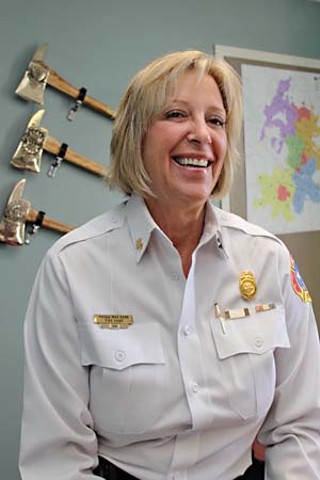
But if you calculate the same numbers as percentages, the new stats look less impressive. This year Hispanics made up only 26.7% of applicants, down about 3.5 percentage points from three years ago. Women? Six percent, down 0.3 percentage points. African-Americans? Ten percent, down nearly two percentage points. As a means of comparison, Hispanics make up 31.4% of Austin's population. So not only do we have a pool of minority and female applicants with numbers that don't reflect citywide demographics, we have a pool of minority and female applicants with numbers that can't even compete with a hiring process from three years ago – when $280,000 wasn't spent on recruiting.
Yet Austin Fire Chief Rhoda Mae Kerr defends the city hiring a consultant. "The recruitment process is successful because the idea of the recruitment process was to bring more people," she tells me. "In terms of recruitment and changing your minority representation, it's a long process. This is our first full-year hard push at this, so we don't know how successful it really will be at the end of the day. It will take 10 years before you really see a difference. You can't change an organization overnight."
But how will you ever get money to extend this program for 10 years? Wasn't it hard enough getting council to agree to $280,000 for 18 months?
The chief points out that of that $280,000, $130,000 went to Hodes, while the other $150,000 was spent on marketing and advertising materials which the city can continue to use. "By using a firm to help us not only with the demographics and the recruitment but the marketing and the publishing of materials, it makes our job easier in the long run," Kerr says. "Hodes produced for us; they gave us the product we asked for. Are our numbers as high as we'd like them to be? No. But overall our numbers did improve."
Of course, the real issue for Kerr and AFD isn't how many minorities and women apply to become firefighters but how many actually become firefighters. Because if recruitment becomes an end in itself, then the process is merely cosmetic, something being done for the media and a slap on the back, and that $280,000 was poured down the drain.
Ducks and Eagles
Chapter 143 of the Texas Local Government Code, known as the Civil Service Act, was written decades ago with the intent to reduce political influence in hiring, training, promotions, and discipline in Texas fire and police departments. Before civil service statutes, those departments tended to be lily-white boys' clubs, where men were hired because their fathers had been cops or their uncles had been firefighters or they knew a guy who shot pool with a guy who worked down at the hiring hall.
Chapter 143 changed that situation by standardizing the hiring process with an exam testing applicants' competitive – or "cognitive" – abilities. These cognitive exams generally test skills in math, verbal reasoning, verbal comprehension, mechanical aptitude, spatial relations, etc. – what folks in the industry call your "technical core."
The problem is, not long after these cognitive tests became the norm in hiring, it was determined that (like many such standardized tests) they have what is known as a high "adverse impact." According to the U.S. Equal Employment Opportunity Commission, that means that there is a "substantially different rate of selection in hiring, promotion or other employment decision which works to the disadvantage of members of a race, sex or ethnic group." In other words, certain "subclasses" of applicants don't do as well in certain parts of a hiring process as others. And in the case of the cognitive, pencil-and-paper, multiple-choice tests Texas fire and police departments were using, there was a high adverse impact for African-Americans and Hispanics, two of the groups departments were hoping to recruit in larger numbers.
Consequently, these days fire and police departments are always looking for ways to reduce adverse impact while maintaining a test that has a "high degree of validity": that is, one that adequately predicts job success.
After protracted and sometimes testy negotiations, the December 2009 collective bargaining agreement between the city and the Austin Firefighters Association expressly gave Kerr flexibility to "design a process intended to have a high degree of validity, a direct job relationship, and to seek highly qualified candidates while minimizing adverse impact." That flexibility means the chief is walking a fine line: Too much emphasis placed on validity, and African-Americans and Hispanics could be adversely impacted; too much emphasis placed on reduction of adverse impact, and you may have a test that doesn't get you highly qualified candidates or that's open to charges of reverse discrimination.
The test that Kerr and third-party vendor I/O Solutions came up with last December (at a cost of about $118,000 for an 18-month contract) and initiated this January aims to strike this balance by making the cognitive ability and behavioral portions of the test pass/fail, with a passing score of 70%. Those two portions together are called the National Firefighter Selection Inventory. Under the current hiring process, candidates who have passed the NFSI then take an Integrity Inventory test, which assesses "counterproductive workplace behaviors and integrity-related personality factors," after which they have a structured oral interview. The composite of the scores earned on those tests determines the applicant's place on the Initial Ranked List. By making the NFSI a pass/fail screener rather than a scored component of one's rank, Kerr is allowing many more applicants to get to the interview portion of the test, where, she believes, potentially good firefighters could get a chance to shine in a way they wouldn't have in hiring processes past.
"We are just opening up the playing field and giving everybody an opportunity to compete, but we're still going to hire the best of the best," Kerr says. "In this situation, we're giving everyone the opportunity to have the interview because that will also help us determine who is going to be the best firefighter. Scoring 100 on a written test doesn't really mean that you're going to be the best firefighter. It means that you take a good written test."
Kerr is quick to point out, as well, that any applicants who make it through this first portion of the process still have to pass a physical test, a background investigation, a psychological screening, and a medical/physical assessment. So by allowing more candidates into the interview portion, Kerr says, the department isn't risking a drop in quality, but it is both improving its chances of getting good firefighters and cutting down on adverse impact.
"We have a saying: You can't send a duck to eagle school," Kerr says. "We cannot teach you to have integrity; we can't teach you to have humor or empathy or compassion. We can't teach you to be a team player. But we can teach you how to be a good firefighter. So not only do we want to hire people that are bright, competent, and able to do the work, but we want to hire people who share our values."
Cognitives and Cores
Bob Nicks isn't so sure.
Nicks is the president of the Austin Firefighters Association and principal author of a grievance filed on Dec. 30, 2010, contesting AFD's 2011 entry-level hiring process (see a copy here) In that grievance, which went to arbitration on April 18, Nicks and his union claim that the new test, despite the obligations enumerated in the collective bargaining agreement and assurances from Kerr, "cannot be said to assure a high degree of validity." Instead, Nicks tells me, Kerr and I/O Solutions ignored the concerns of the union and came up with a test that puts too much emphasis on the reduction of adverse impact.
"My gut feeling is that the chief made some changes to the test only to reduce adverse impact without much regard to keeping the test valid, seeking highly qualified candidates, and making sure there's a direct job relationship," Nicks says. "What we're thinking is they're really making cognitive ability almost zero and then going on all personality constructs, which means you might get people who don't have technical skills; they're not even trainable to become good firefighters." According to Nicks, in the firefighting industry, the cognitive test is the "best predictor" of an applicant's future success, both in the academy and in the firehouse.
Trainability and technical skills are of particular concern for his membership, Nicks continues, most of whom have to entrust their lives to the person next to them when they rush up the stairs of a burning building. "Firefighters care about the quality of the people working next to them. The worst-case scenario is we have a firefighter who is not cognitively suited for the job but he's out there on the streets providing care," Nicks says. Cognitive ability, your technical core: That's what matters, or so say Nicks and International Association of Fire Fighters Local Chapter 975. "Whether I come to work or I'm an alcoholic or I'm nice to guys at the station, those are all important things. But when you're in the street delivering care, none of those things matter anymore," Nicks says. "It's your technical core that matters."
I ask Nicks why his union felt the need to file a grievance against the department. Is it because the NFSI test is being used as a screening tool rather than as a scored portion of the compensatory model?
Nicks says that's part of it, that ideally an applicant's score on the cognitive portion of the test would be a part of that applicant's final grade. That way, even if the NFSI is used as a pass/fail screener, an applicant's scores on each individual part of the test would still be used to differentiate candidates in their final analysis. In this way, the department can assess applicants without "information loss," without leaving behind the results of any part of an applicant's test, especially the cognitive part – one's technical core.
But the main source of the union's grievance, Nicks says, comes down to Kerr's decision to combine the cognitive and behavioral portions of the test into one composite pass/fail grade. Combine those two, he says, and there's a very real possibility that a candidate could get a 100% on the behavioral portion but 40% on the cognitive and still come up with the composite 70% required to get to the next phase of the hiring process.
In other words, hypothetically, by the standards of the current hiring process, you could have a person moving on to the second phase of the hiring process who has displayed almost no cognitive – or technical – ability. And that scares Nicks and his fellow firefighters.
"You could have high emotional intelligence; you're really empathetic; you have good verbal communications; you may score really high on this part and not really have any of the cognitive abilities to do the job," Nicks says. "That increases the chances that a person who is incapable of doing the job could be getting through the process." For Nicks and his membership (92% of whom voted to take the hiring process to arbitration), this is what can happen when a department skews the balance too far in the direction of reducing adverse impact.
Kerr, however, says that she isn't worried about such a nightmare scenario, one in which a candidate with perfect behavioral intelligence and near-comatose cognitive ability somehow manages to get through to the Integrity Inventory and the oral interviews. She believes there are too many fail-safes built into the process. "In discussion with our testing experts, they tell us that the chance for that to happen is so extreme that we shouldn't worry about it," she says. "Statistically, it just can't happen. And if it did, it's not really going to make a difference because they're not going to get much further if their cognitive is that low."
As for Nicks' complaint that Kerr ignored the concerns of the firefighters union, Assistant City Manager Michael McDonald says the chief went out of her way to listen to and address those concerns, but that ultimately the call was hers to make. "I listened to what he had to say, but at the end of the day, the union was trying to assert itself into areas that are not the union's prerogative. As long as Chief Kerr operates within the constraints of the contract, it's her decision, not theirs," McDonald says.
"The chief is involving the union a lot more than she has to. When Nicks says nobody got back to him in a certain period of time, nobody had to. Everything Kerr is doing, she's doing to be more inclusive. To speak as if she violated something, that's just not the case."
And as for splitting the NFSI test into two separate graded portions, Kerr says that was never an option: "At no point did we have the cognitive separate from the behavioral. It's always together in the NFSI. It wasn't developed to be graded separately."
A Fading Generation
The issue of racial diversity in the Fire Department is a minefield no matter which direction you walk. Attempts by the Chronicle to talk to Mayor Lee Leffingwell and Mayor Pro Tem Mike Martinez – the recruitment process' two principal antagonists, who in April 2010 strongly disputed the need for a consultant, and whose resulting emails calling Kerr a "company man" and McDonald and City Manager Marc Ott "jokes" would soon become the stuff of municipal scandal – were thwarted by aides and lawyers. One aide of Leffingwell's told me that the mayor had been advised by lawyers not to speak to anyone on Fire Department matters. Not only because of the union's ongoing grievance, but because the mayor had recently given his deposition on a complaint filed in late 2009 with the EEOC by Assistant Fire Marshal Don Smith and Battalion Chief Greg Nye, two white firefighters who claim they were passed over for promotions "in order to accommodate a race-based political agenda." So when I went looking for him, Leffingwell was busy getting burned by both sides of the diversity debate, and he was sufficiently lawyered-up enough to know not to talk to any reporter about anything having to do with fires or the people who put them out for a living.
There are some who see the Austin Firefighters Association's grievance against the city as a reflection of the department's long tradition of racial insularity, as an attempt by a historically monochromatic union (what Austin NAACP President Nelson Linder has called the "White Firefighters Association") to ensure that minority and women firefighters don't upset the statistical balance of the department.
But Nicks says that's just rhetoric: "It's an age-old criticism: If I want to raise standards, all of a sudden I'm a bigot. Unfortunately, there have been these battle lines drawn between standards and diversity. People say if I want standards, I'm against diversity; if I want diversity, I'm against standards. Both of those arguments aren't true. We just want a quality process. We want to reduce adverse impact; we just don't want to give the farm away to get there. We want highly qualified candidates."
For Austin African-American Firefighters Association President Bobby Johns, the union's grievance may not be an act of conscious bigotry, but it could be doing just as much damage by slowing down a minority-friendly hiring process right at a time when the number of minorities in AFD, particularly of African-Americans, is in danger of plummeting.
About 35 years ago, in 1977, the U.S. government filed a complaint against the city of Austin alleging that its Fire Department was engaged in a pattern of discrimination in employment on the basis of race, sex, and national origin, in violation of Title VII of the Civil Rights Act of 1964. The city denied the government's claim but agreed to a five-year consent decree to resolve the issues raised by the complaint. Under the terms of that decree – which required the department to hire African-Americans for about 20% of all entry-level firefighter positions, Hispanics for another 20%, and women for "a percentage approximating their proportionate applicant flow" – the department developed a targeted "affirmative" recruitment process and a testing process whereby all applicants who passed a physical agility test and an oral interview were accepted into a 20-week fire cadet training program. The written examination came only after the successful completion of that program and only addressed material covered in that program.
What the successes of the consent decree era seem to argue is that without an initial cognitive test, there is no adverse impact to speak of. Give all qualified applicants the proper schooling and then test them on what they learn, and the results are a much more diverse, equally efficient department: low adverse impact, high validity.
The consent decree lasted five years, from 1977 to 1982, and during that time, minority representation in the department skyrocketed. Of the 287 firefighters hired during those years, 125 were white, 74 were black, 69 were Hispanic, and 19 were women. African-American representation in the 1977 cadet class alone was at 27%. The next year's was even higher. And during the five years of the decree, those percentages remained in the twenties. Come January 1984, though, the first time the city had a hiring process after the close of the consent decree, the number of black cadets in the fire academy dropped to 2%. Later that year, an academy class saw zero black cadets. Between 1984 and 1996 – more than twice as long as the consent decree era – the city hired 619 new firefighters. Of those, 521 were white, 67 were Hispanic (11%), 19 were black (3%), and only 12 were women (2%).
And as the numbers released in January are showing, African-American representation in the department has never really recovered. The real problem for Johns and others concerned about diversity in the department is that much of the "consent decree generation" has either retired or is about to retire. In the past three years, the number of African-Americans in the department has fallen from 59 to 48, and Johns worries that if more proactive measures in recruitment and test-writing aren't taken, AFD risks becoming what it was before 1977: an exclusive home for white males.
"We foresaw this drop-off years ago, and we tried to curb it over the years, but it was almost inevitable," Johns says. He supported the city allocating money to hire an outside recruiter (for which he appeared in a negative light in those notorious council emails), but he didn't support hiring the Bernard Hodes Group and says he's disappointed in the results of the city's recruiting efforts. "The recruitment numbers are more," he said, "but if we're talking about better, then I would have to say no."
Linder, president of the Austin NAACP – who filed his own ethics complaint against members of City Council following last April's debate and resulting email debacle, for being what he calls "tools and pawns of the firefighters union" – believes that minority, and particularly African-American, recruitment numbers won't go up unless there's a cultural change in the department.
"Until you change the process and the culture, you're not going to have higher numbers," Linder says. "If you don't retain black firefighters, the numbers are not going to change. The Fire Department is not using their top black firefighters in the right way. I would say get the folks who have been through the process and have them help with recruiting. They can tell stories to these young black men and say, 'This is a great job with great benefits.'"
Johns believes that AFD has a long way to go to make itself a welcoming environment for minorities and women, and it will continue to have a long way to go as long as targeted recruitment efforts don't work. "Tradition is what we're fighting against. And that tradition, both in Austin and across the country, is the notion that you want the person you're sleeping in the same room with to be like you," he says. "You're definitely working on hearts and minds in the department, because some things are ingrained in people. We are the sons and daughters of our parents, and one of the things they instill in us is to be like them."
In response to the only reasonable question one could ask at this point, AFD spokesperson Michelle DeCrane told me the reason we don't just adopt the lessons learned from those consent decree years, scrap our current hiring process, and send aspirants to class before making them take a test is because a "consent decree is issued by a court, and we are required to comply with that decree by law. Since we are currently not under a consent decree, we must abide by the collective bargaining agreement and civil service law."
Which is to say that a contract between the Austin Firefighters Association and the Fire Department designed to ensure that the validity and adverse impact associated with a hiring process are kept in balance is preventing the AFD from employing a hiring process that has been proven to strike a balance between validity and adverse impact.
As Yossarian might say, that's some catch, that Catch-22.
Still Waiting
All the arguing between the Fire Department and the Austin Firefighters Association, all the disagreements among Nicks and Kerr and McDonald over whether the test puts too much emphasis on reducing adverse impact or on increasing validity, all the concern about the consent decree generation and dwindling African-American numbers, all the cranky emails and open-records requests – all of that obscure the fact that whatever the merits of the current testing process, much like the current recruitment process, it hasn't done yet what it was supposed to do – increase the number of minorities moving forward through the hiring process, thereby increasing the chance for higher percentages in the next cadet class.
Making the NFSI pass/fail may have been the best way to reduce adverse impact, but the fact remains: Of the 2,378 applicants who passed the written tests this year (and who are moving on to the structured oral interviews), only 576, or about 24%, are Hispanic, and 158, or about 7%, are African-American. That's a slip, both in hard numbers and percentages, from the 2008 statistics. (The number and percentage of women passing the written test actually went up this year, but women as a group have not been shown to be adversely impacted by written tests like the NFSI.)
It's possible, of course, that those numbers represent merely the first steps taken in two long processes – recruitment and testing – to improve diversity at AFD. As Kerr says, changing the culture of a municipal department takes time, and a couple of 18-month trial runs along with a few hundred thousand dollars in marketing materials and freshly minted tests aren't going to make up for 100 years of discrimination and willful insularity. In the meantime, the city is left to wonder if at long last it's on the path toward diversity in the Fire Department or if it's staring at the cold, dark reality that it's still a long way away from making the Austin Fire Department look more like the city it serves.
Got something to say on the subject? Send a letter to the editor.





